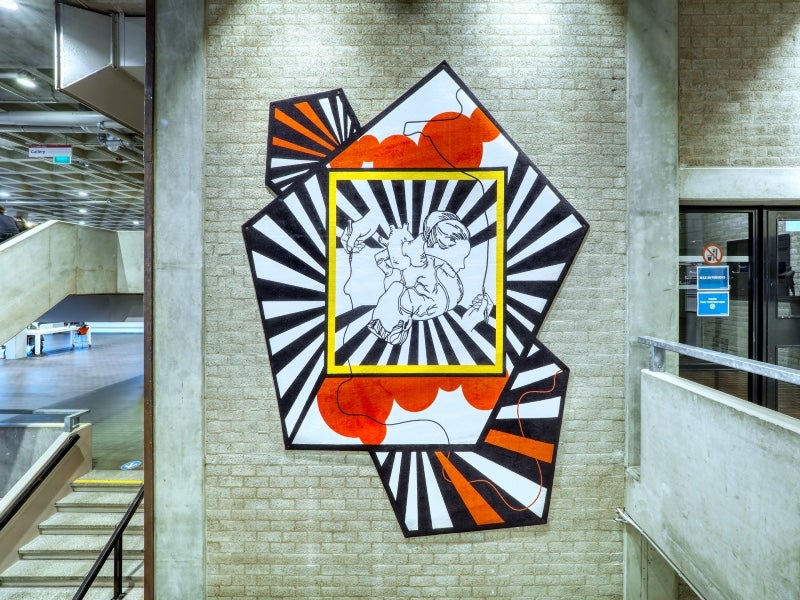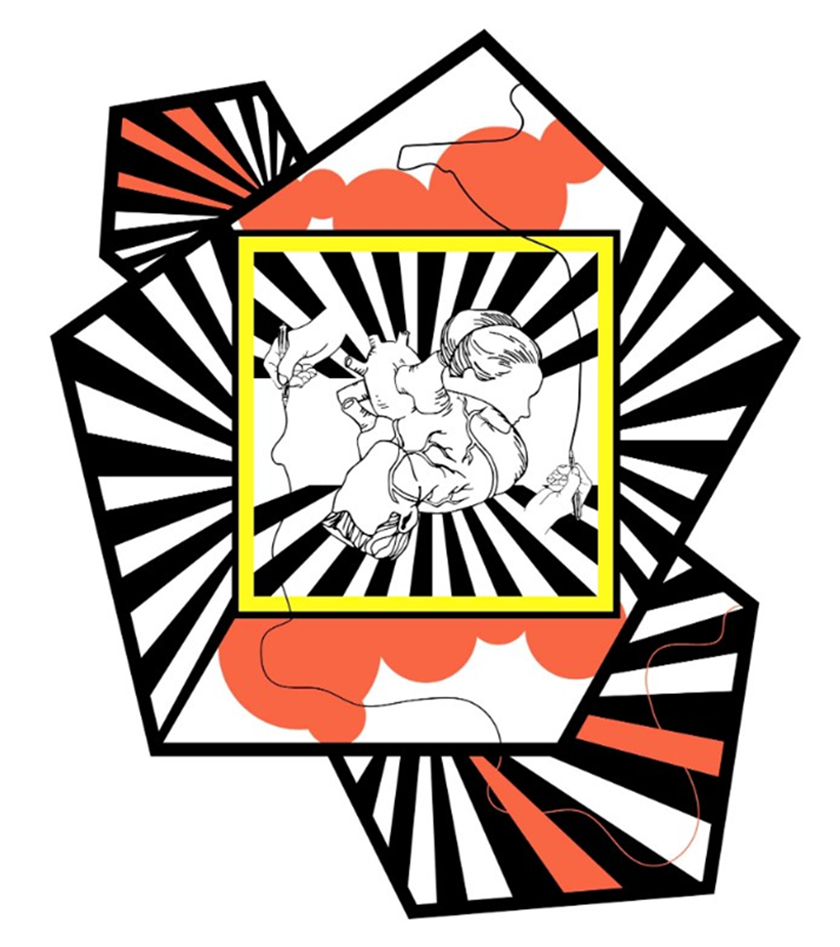Ahalouch, Wafae - VM - Marleen Hengelaar
Wafae Ahalouch, Trinity: Kuyper Revisited

The Trinity of Head, Heart and Hand
by Marleen Hengelaar-Rookmaaker
In the academic year of 2020-2021 the Free University in Amsterdam celebrated its 140th year of existence. Abraham Kuyper was the founder of this university, while in 2020 it was also 100 years ago that Kuyper died. Moroccan artist, Wafae Ahalouch, received the commission to make an artwork to mark the Kuyper year. This resulted in the tapestry Trinity: Kuyper Revisited, which was hung at the entrance of the Free University’s auditorium.
Who was Abraham Kuyper? Kuyper (1837-1920) was a theologian, pastor, statesman and journalist. He was the founder not only of a university but also of the first political party in the Netherlands, both of Reformed persuasion. He stood at the cradle of a new Reformed denomination and he was the godfather of a renewed and updated Calvinism: neo-Calvinism. In 1901-1905 he was prime minister of the Netherlands. The website of the Free University: “The way in which the apparently inexhaustible Kuyper gave new form to society in politics, education, the church, science and the press remains a source of inspiration. Not only for the Free University, but also outside of it.”
Already early on Kuyper was looking for an integrated Calvinistic worldview, in which all his knowledge, convictions and activities could merge into a coherent whole. The basis for this coherence is formed by the idea that Christ is the sovereign Lord over all of reality. Kuyper moreover considered each area of life to have its own independent, God given authority, such as the state, the family, the economy, the church, religion and also art. Every sphere is irreducible to another, obeys its own laws and grows to maturity only when it can develop independently and in complete freedom. What is unique in Kuyper’s Christian conceptual framework is that art constitutes an inextricable part of the whole and that it sees the aesthetic sphere as an essential element of human life.
Ahalouch’s tapestry gives us a fine visualization of Kuyper’s idea of coherence. In the title ‘Trinity: Kuyper Revisited’ the artist speaks of a trinity, alluding to the connectedness of the head, heart and hand. She says: “I knew Abraham Kuyper as a statesman, but not as a philosopher or theologian. That’s why I delved into the Free University’s archives. There I came across one of his pronouncements: ‘God created a magical unity between the mind, heart and hand.’ I was touched that he mentioned the heart. The mystical character of the heart seems to transcend the religious man that he was.” Ahalouch found this three-part unity to be applicable to her own life and art as well as to all of human existence. All three are necessary to be a complete human being. This also applies to the Free University, where students develop themselves not only as scholars and professionals but also as human beings.

In the tapestry’s center sits a yellow-edged square. Inside the square we see the outlines of the heads of a man and a woman, an anatomical heart, and two hands holding pens that have drawn lines that continue a long way. It is significant that it is two writing hands that stand for ‘the hand’, as Kuyper’s writing made up a large part of his pursuits. The square is placed within a pentagon, from which a three-pointed projection protrudes at the top and the bottom.
Each of these elements is partly or completely filled with black, white and orange beams. We also see two orange cloudlike structures. The clouds, the circus-tent-like stripes, sharp black lines, geometric patterns, and primary colours are a returning feature in the work of Ahalouch. They draw on the visual language of the graphic novel. They add a light-footed, relativizing note to the work and lend it a non-elitist character, which Kuyper definitely would have appreciated. About the colours she says: “In colour theory orange stands for spirituality and yellow for energy and God’s light. In the work yellow is literally a frame for the human relationship that is connected with the heart, knowledge (the head) and science (the written).”
The outward directed points and beams create a dynamic effect of emanation, enhanced by the erupting orange clusters. They seem to point to Kuyper’s great influence. He was not an introverted scholar, but a man with a huge determination to help his country and fellow believers forward. This influence was not limited to just one area, but went in several directions, as indicated by the three large arrows. From here it is not a big step to see in the black, white and orange stripes the spheres of life that are so characteristic of Kuyper’s thinking, in which he differentiated between all areas of society and life and accorded each its own place and value. Thus the artwork pays tribute to Kuyper’s faith driven engagement – with head, heart and hand – with all of reality.
*******
Wafae Ahalouch, Trinity: Kuyper Revisited, 2020, 3 x 4 m, tapestry, Free University Amsterdam. Source photo 1: VU Magazine; source photo 2: Tapestries – Wafae Ahalouch el Keriasti (wafae-ahalouch.com).
Wafae Ahalouch El Keriasti (Tanger, Morocco, 1978) lives and works in Amsterdam, the Netherlands. She graduated from HKU University of the Arts Utrecht in 2001, followed by residencies at De Ateliers and later Rijksakademie van beeldende kunsten, Amsterdam (among others). She has received national and international recognition in the form of various fellowships, stipends, and awards, including, in 2003, the Koninklijke Prijs voor Vrije Schilderkunst (the Dutch Royal Prize for Modern Painting). Over the course of her career, her work has been shown in solo and group exhibitions at venues inside and outside the Netherlands. www.wafae-ahalouch.com
For an article about Kuyper and art, click here
Marleen Hengelaar-Rookmaaker is ArtWay’s editor-in-chief.
ArtWay Visual Meditation November 13, 2022


